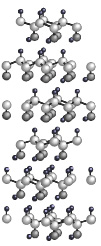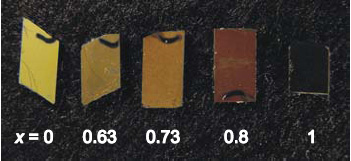Welcome to the Brandt group
Group leader: Prof. Dr. Martin Brandt
Sheet polymers
To some researchers, realizing light emission from Silicon is one of the holy grails of semiconductor physics and technology. Efficient light emission from crystalline Silicon is effectively forbidden due to the indirect electronic band structure of the material. However, the luminescence intensity can be significantly increased by breaking the translational symmetry. Different approaches to realize this are summarized in the figure below, including the incorporation of impurities, the folding of the band structure, the introduction of disorder or the reduction of the dimensionality. One famous Si-based material in this respect is porous Silicon, where by electrochemical etching a network of Si nanocrystals is formed, exhibiting a bright red luminescence.

A single-crystalline Si material that does show a bright luminescence is siloxene. It was first synthesized by Wöhler already in 1863 and exhibits both a bright yellow color and fluorescence. It consists of two-dimensional layers of Silicon atoms, somewhat analogous to graphite. However, since Si atoms cannot from sp2 hybrids easily, the fourth valence is passivated by H- or OH-groups. This sheet polymer can is obtained via a so-called topochemical reaction from CaSi2, a Zintl phase containing the same puckered Si layers also found in siloxene.

During recent years, we have systematically studied the preparation of epitaxial thin films of siloxene on Si substrates and have synthesized the corresponding Ge and Si1-xGex sheet polymers for the first time. In each case, the first step is the growth of the corresponding Ca-based Zintl phases by reactive deposition epitaxy, followed by their topochemical transformation in hydrochloric acid. We have studied the growth of the epitaxial Zintl phases and their polytypism caused by strain using X-ray diffraction, investigated the kinetics of the topochemical transformation and determined the optical properties of the sheet polymers both experimentally as well as theoretically. Using this material system, we can in particular realize Si-based luminescence at any energy from the near infrared to the yellow part of the optical spectrum. The unique properties are also reflected in the vibrational properties, where a characteristic anti-crossing of the local vibrational modes of the H atoms with the Si phonon is observed. Not surprisingly, due to the large surface siloxene lends itself to ligand substitution, which is actively investigated at this time.
Review publications
-
Silicon- and Germanium-Based Sheet Polymers and Zintl Phases
in P. Jutzi and U. Schuberts (Eds.), Silicon Chemistry: From the atom to extended systems (Wiley-VCH, Weinheim, 2003), p. 194
M. S. Brandt, G. Vogg, M. Stutzmann




 During recent years, we have systematically studied the preparation of epitaxial thin films of siloxene on Si substrates and have synthesized the corresponding Ge and Si1-xGex sheet polymers for the first time. In each case, the first step is the growth of the corresponding Ca-based Zintl phases by reactive deposition epitaxy, followed by their topochemical transformation in hydrochloric acid. We have studied the growth of the epitaxial Zintl phases and their polytypism caused by strain using X-ray diffraction, investigated the kinetics of the topochemical transformation and determined the optical properties of the sheet polymers both experimentally as well as theoretically. Using this material system, we can in particular realize Si-based luminescence at any energy from the near infrared to the yellow part of the optical spectrum. The unique properties are also reflected in the vibrational properties, where a characteristic anti-crossing of the local vibrational modes of the H atoms with the Si phonon is observed. Not surprisingly, due to the large surface siloxene lends itself to ligand substitution, which is actively investigated at this time.
During recent years, we have systematically studied the preparation of epitaxial thin films of siloxene on Si substrates and have synthesized the corresponding Ge and Si1-xGex sheet polymers for the first time. In each case, the first step is the growth of the corresponding Ca-based Zintl phases by reactive deposition epitaxy, followed by their topochemical transformation in hydrochloric acid. We have studied the growth of the epitaxial Zintl phases and their polytypism caused by strain using X-ray diffraction, investigated the kinetics of the topochemical transformation and determined the optical properties of the sheet polymers both experimentally as well as theoretically. Using this material system, we can in particular realize Si-based luminescence at any energy from the near infrared to the yellow part of the optical spectrum. The unique properties are also reflected in the vibrational properties, where a characteristic anti-crossing of the local vibrational modes of the H atoms with the Si phonon is observed. Not surprisingly, due to the large surface siloxene lends itself to ligand substitution, which is actively investigated at this time.